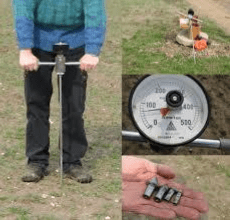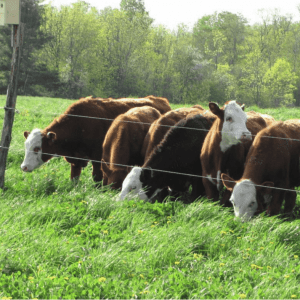Adapted from resources developed for a SARE Grant titled Identification and Remediation of Compaction on Northeast Pasture Soil. Contributors include Fay Benson, Abbie Teeter & Nancy Glazier.
Understanding Soil Compaction
Soil health is generally described to include the chemical, biological, and physical natures of the soil. The chemical nature has often been the focus of many farmer’s interest, since it has an immediate impact on pasture productivity. Only recently have farmers become more aware of the other two natures of soil health, biological and physical. The most dominant physical issue in pasture soils is compaction.
A simple test to determine if soil compaction in your pastures is evident is to take a fiberglass post and push it in the pasture soil, and then walk over to a fence line (ideally that has been in place for 5 or more years) and compare the resistance to pushing the post into that soil. If there is a noticeable difference, then your soils are probably compacted.

When a soil is compacted, air space is squeezed out of the soil which can be seen in the figure to the right. Root growth takes place in the air spaces around soil particles, therefore soil compaction contributes mechanical resistance to root penetration, which limits the nutrient and water uptake. It also inhibits the emergence of seedlings and spreading of rhizomes. Clay textured soils are the most easily compacted, while sandy soils are the least. Alluvial soils in bottom lands and fine textured silt loams are also easily compacted. With compacted soils, organic matter is reduced as well as overall soil health.
Levels of organic matter are a key indicator of a healthy soil. Here in the Northeast, 5% to 6% organic matter is attainable, and should be the goal of graziers.
Intensive livestock use of a pasture can eventually reduce the lands productivity as the ground becomes compacted. When desired grasses start to diminish due to compaction, weeds take over. Weeds are aggressive, and efficient at getting established. Many of the worst problem weeds are broadleafs, exhibiting a taproot system rather than the fibrous roots common to pasture grasses. Weeds can survive in compacted conditions better than grasses because taproots can penetrate compacted soils. Once the weeds overtake grasses, the tendency is to apply herbicides for control. This results in costs that could have been avoided, and the addition of unneeded pesticides into the environment.

Compaction also affects the biological properties of soil. Healthy soils are a thriving ecosystem, with bacteria, earthworms, fungi, and other organisms that help break down organic materials and recycle nutrients. These organisms exist in the pore spaces within healthy soils, so soil compaction directly impacts their ability to function. The exchange of nutrients from microbes to plants and plants to microbes is the cornerstone of healthy soils creating healthy plants, which create healthy animals and eventually healthy food.
Preventing Compaction in Pastures
The best way to deal with compaction is to implement practices that prevent it from ever becoming a serious issue. The keys to preventing compaction are to maintain a healthy and vigorous plant root system and prevent constant or consistent livestock/equipment traffic. These management techniques will not only help prevent compaction, but will also provide other production benefits.
- Maintaining a healthy and vigorous root system is directly related to the amount of time between grazing or cutting of grasses. Whenever grass is cut or grazed, the plants take energy out of the root system to regrow the foliage above-ground. If pastures are continuously grazed, or hayfields are cut too short or too often, grasses will be overstressed and have very short root systems that cannot work down into the soil profile to add organic matter and contribute to healthy soil structure.
- Monitoring soil fertility is very important. Soil sampling and fertility testing will help you determine if forages are receiving what they need to be productive.
- Reducing livestock traffic and equipment movement will help prevent compaction issues. Over time, livestock can exert as much force on soils as heavy equipment. Reducing foot traffic relates back to grazing management. When cows are pulled off and moved to another paddock rather than continuously on one pasture, soils are allowed time to preserve some of their structure and maintain pore space.
- Knowing how soil conditions are related to weather conditions allows farmers to modify their management strategies in response. Soils are more easily compacted in wet conditions, so keeping cows or equipment off bottom lands or areas that would be wet will help mitigate damage.
Remediating Compacted Soils
If your soils are compacted, aeration is often seen as the solution. However, in forage and hayfield applications, research has shown that aeration is, at best, a temporary solution. Studies comparing fields with aerated vs. non-aerated areas tend to only show a difference in performance for 1-2 years. Short-term benefits or improvements are usually more a result in tillage or disturbance that releases nutrients from organic matter. Results from studies in the past have shown that aeration and deep tillage could alleviate compaction in severe cases, but studies have also shown that these methods do not help, or can even make things worse. With this variability in benefits, the costs of aeration are unlikely to be a worthy investment.

The most effective methods of remediation include:
- Rolling out the hay if you “balegraze” animals, so livestock doesn’t stand in one place for an extended period of time.
- Allowing compacted pastures to be harvested for hay. By allowing the plants to become taller their roots grow longer and can work at loosening the soil through root action.
- Tiling wet areas. This will help improve areas that are prone to wet soils, which are easily compacted.
- Adding organic matter to the soil to improve the biological functions of the soil.
Compaction is a real and serious concern for forage and livestock producers. Soil types can play some part in this, with heavier, clay soils more likely to suffer from compaction than sandier soils. Utilizing a farm’s better soils for pasture will return benefits. Using wet areas that aren’t suitable for crops and are easily compacted will only lead to environmental degradation and erosion. Management plays a large role in preventing compaction from becoming a serious concern. Promoting practices that increase soil health and soil organic matter is the best way to prevent compaction from reducing your farm’s performance.
The “Pasture Compaction Ratio” (PCR)
Part of the Northeast SARE grant Identification and Remediation of Compaction on Northeast Pasture Soils is to test the usefulness of a technique to measure compaction in pastures that is independent of the moisture level of the soil.
A penetrometer will read different resistance readings in the same area at different times depending on the moisture of the soil. During this project, we plan to use penetrometer readings from under an established fence line and from a nearby pasture.

The resistance measurement from under the fence line will be called “optimum resistance” because no livestock or machinery can impact that area. Similarly, the measurement from 10-20 feet away in the pasture will be called the “working resistance” as that area can be impacted over time. The ratio of these two readings will be calculated and will be called the Pasture Compaction Ratio. Our hypothesis is that the ratio will stay the same even as the moisture level of the soil changes, with the goal of finding a reliable measurement for farmer to use to monitor the compaction changes on their land.
Testing this hypothesis will require taking hundreds of penetrometer readings throughout the 3 years of the project. If you would like to learn more or participate please contact Fay Benson at afb3@cornell.edu.

